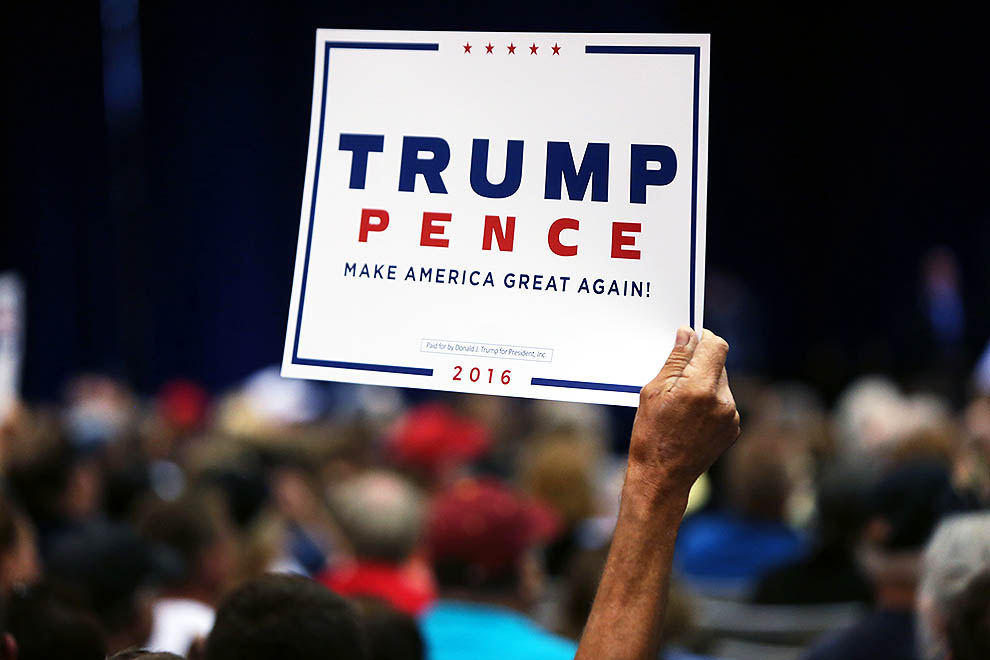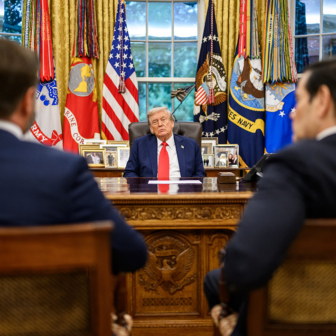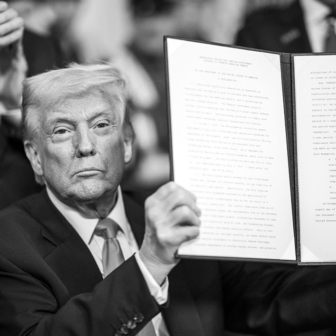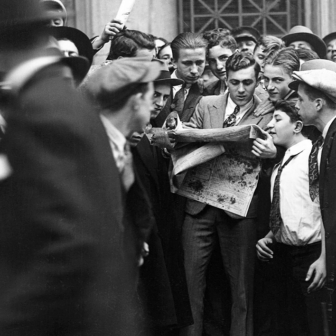Some three weeks after the party conventions and with another eleven weeks before election day, Donald Trump’s presidential campaign appears to be in serious decline – and the trend is almost totally of his own making.
Going into their respective political conventions as the obvious nominees, Trump and Hillary Clinton had similar tasks: to unite their parties. Clinton needed to reach a rapprochement with Bernie Sanders and get his supporters on board. She also had to address her high unfavourability levels, and to do that she shrewdly used surrogates to vouch for her and her policies. In a well-organised and coordinated convention, the Democrats were able to wrap themselves in issues of patriotism normally the prerogative of Republicans and downplay vocal challenges from disappointed Sanders supporters.
Trump, too, needed to stare down his opposition and unite the party – and he needed to show that he could be presidential. He succeeded in achieving the former for two reasons: because Republican Party officials ducked the issue of dumping him, partly for lack of any obvious replacement, and partly because the one issue that can unite Republicans is their visceral dislike of Clinton. But otherwise he played wilfully to his narrow support base and ensured that the convention was all about himself.
The extent to which Trump blew his opportunities at the convention was highlighted by the shocking fact that Republicans were less likely to vote for him after the convention than before. Clinton, on the other hand, had gained 86 per cent of Sanders’s supporters and made significant gains among Democrats (up 5 per cent), Independents (up 9 per cent) and those who supported a Republican other than Trump in the primaries (up 5 per cent). And people were now more likely to make a positive vote for her rather than simply cast an anti-Trump vote. Clinton succeeded in her convention tasks; Trump did not.
The most recent polls show that the early post-convention surveys accurately predicted what has been a trend of growing support for Clinton and flagging support for Trump. The RealClearPolitics average of August polling has Clinton ahead by six points. Both candidates have high unfavourability ratings, but Clinton’s favourability is improving as Trump’s worsens.
Clinton does better than Trump among almost every demographic group except white men without a college education. Their response to Trump may be as much about their perception of a woman president as it is about their own economic status.
Polling from a range of sources highlights the extraordinary role that Americans’ race and ethnicity play in determining how they view the two candidates. Trump gets only 1–2 per cent of the African-American vote overall. That makes many southern states with significant numbers of African Americans look very shaky indeed for him. In Georgia – long considered a Republican stronghold – just 58 per cent of registered voters are white and 31 per cent are black. That means there are not many working-class white voters for Trump to win but lots of well-educated white and black voters for him to lose. Clinton is currently ahead in Georgia in most polls.
Those states with Republican governors have tried to counter Clinton’s demographic advantages by instituting tough voter-identification requirements and limiting voting booths in some areas. Every Alabama county in which African Americans make up more than 75 per cent of registered voters has seen the closure of drivers licence bureaus, making it hard for voters to get the ID they need for election day. The situation has been described as the worst since the Jim Crow era, prior to the enactment of voting-rights laws.
Clinton currently has a forty-eight-point advantage over Trump among Hispanic registered voters. In a key state like Florida, only 13 per cent of Hispanics support Trump and 76 per cent support Clinton.
The animosity of Hispanic voters has Republican Party officials increasingly concerned. Population growth rates mean that if Trump wins the same percentage of the Hispanic vote in 2016 as Mitt Romney did in 2012 (27 per cent), he would have to win 64 per cent of the white vote. No Republican has done that since Ronald Reagan’s re-election landslide in 1984.
The key, however, is not the national vote but the 270 electoral college votes needed for victory. The policy wonks have come up with a list of between seven and twelve battleground states, and the news for the Republicans is grim. In a sign of where this election looks to be headed, some states that are traditionally seen as pivotal, like Colorado, Virginia and Pennsylvania, are already consigned to the Clinton column. Of the ten closest races in 2012, President Obama won nine of them. Right now, Donald Trump trails in all but one.
Trump needs to win everything Romney won in 2012 and then pick up some states, especially those with higher numbers of electoral college votes. Florida will be key; it’s hard to chart a winning course for him without it. But the RealClearPolitics average of the polls has Clinton leading by 4.5 points in Florida and by 2.5 points in North Carolina, and these margins are greater in recent individual polls.
Even some traditionally Republican states seem to be slipping away. In Utah, which has not voted for a Democrat for president since 1964, the Mormon population has a strong distaste for Trump, whose attacks on Muslims have led to concerns about their own religion being victimised. Utah has moved from safe to leaning Republican. Mormons also have a strong presence in Arizona, Idaho and Nevada, and may sway elections there.
Thus emboldened, the Clinton campaign is looking to move into Utah. Meanwhile, with what seems like a complete lack of strategy, Trump is campaigning in Connecticut, which he can’t possibly win.
The New York Times Upshot column now gives Clinton an 87 per cent chance of winning, Nate Silver’s FiveThirtyEight puts it at 88.3 per cent, and even the conservative estimates of the Cook Political Report give Clinton at least 272 electoral college votes. The Senate and House races are being affected, too: it’s now likely the Democrats will have a majority in the Senate, although that’s a bigger ask in the House. Having at least some control of Congress will be important for a President Clinton to protect Obama’s legacy and build her own.
Although it’s not yet certain that Trump has reached the place where recovery is impossible, an increasing number of senior Republicans have come out against him. And many more, especially those up for re-election, have distanced themselves. This week, he announced significant changes to his campaign staff, but these new people and Trump’s own statements (“I am who I am. It’s me. I don’t want to change”) don’t signal any significant change in demeanour or approach. Trump’s campaign remains all about Trump.
In contrast, Clinton has some great surrogates to campaign for her – key among them President Obama, who is anxious to see her help perpetuate his legacy in areas like healthcare reform. How Clinton handles Trump’s nastiness and lack of substance in the debates will be critical for public opinion. She must hit back at his nonsense but can’t afford to get down in the gutter with him.
It seems that Trump and his campaign team have also miscalculated the time they have available to rescue the campaign. Campaign adviser Paul Manafort has been quoted downplaying current polls and saying, “We don’t plan on winning in August – we plan on winning in November.” But thirty-five states allow early voting, and that starts as soon as 23 September. In 2012, nearly 32 per cent of voters cast their ballots before election day.
Clinton has a solid and extensive organisation that is incredibly well funded and targeted at getting out the vote where it matters. Trump has exhibited little of this attention to detail and has only recently begun fundraising. To July 2016, Clinton had raised over $374 million (candidate $264 million; SuperPACs and PACs $110 million) and spent $196 million. Trump had raised $99 million (candidate $89 million; SuperPACs and PACs $10 million) and spent $63 million. As of this week, Clinton had aired $61 million worth of general election commercials, including an $8 million package of TV ads to appear during NBC’s Rio Olympics coverage, while Trump had spent nothing. Admittedly, he has benefited from unreasonable amounts of free media.
Trump is clearly expecting that the Republican National Committee will come in to assist him with fundraising and organisation, especially at the state level. But there are rumours that the Republican leadership might cast Trump adrift in disgust and use the party’s resources to keep seats in Congress.
Finally, the unusually high unfavourability ratings for both Trump and Clinton might mean more ticket-splitting than has been seen in recent elections. They might also mean that people are more likely to vote for a third-party candidate. Fourteen minor parties are running presidential/vice-presidential tickets, eight independent candidates are on the ballot in at least one state, and there is a huge number of independent candidates who aren’t on the ballot and will rely on voters to write in their names – a unique feature of US elections.
Three tickets probably bear watching. The Libertarian Party is running Gary Johnson, a former governor of New Mexico, and he could pick up Republican votes in western states. Jill Stein, a former doctor from Massachusetts, is running for the Green Party and may attract former Sanders supporters. Evan McMullin, a former Republican strategist from Utah, is running as an Independent (anti-Trump) candidate.
Third-party candidates rarely make an impact, although in 2000 Ralph Nader, running on a Green Party ticket and picking up only 2.7 per cent of the vote, was arguably a real spoiler for Al Gore.
Between now and 8 November are likely to be some nasty times. Assuming the polling trajectory is maintained, how will Trump take losing? He is already challenging the debate formula, claiming that the media is biased and the election is rigged, and is looking to set up his own election scrutineers. After polling day, there will be recriminations all round on the Republican side if Trump loses, especially if there are major Congressional losses. However he leaves the presidential race, Trump will leave the GOP and the United States worse off. •




